Deutsches Romantik-Museum, Frankfurt
Reviewed by Mechthild FendMechthild Fend
Professor of History of Art, Goethe-Universität Frankfurt
Email the author: Fend[at]kunst.uni-frankfurt.de
Citation: Mechthild Fend, installation review of Deutsches Romantik-Museum, Frankfurt, Nineteenth-Century Art Worldwide 21, no. 3 (Autumn 2022), https://doi.org/10.29411/ncaw.2022.21.3.9.
This work is licensed under a Creative Commons Attribution-NonCommercial 4.0 International License  unless otherwise noted.
unless otherwise noted.
Your browser will either open the file, download it to a folder, or display a dialog with options.
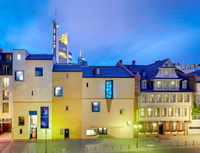
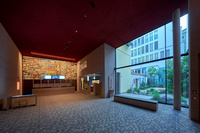
In autumn 2021 the Deutsches Romantik-Museum in Frankfurt am Main—priding itself in being the world’s only museum specifically dedicated to the period of Romanticism—opened its doors to the public in a stunning new building that provides a permanent home for the art collection and archives of the Freies Deutsches Hochstift. Designed by the Frankfurt-based architect Christoph Mäckler and his firm, the museum is situated at Großer Hirschgraben, a street in Frankfurt’s historic center and right next to the Frankfurter Goethe-Haus (fig. 1). The latter, a spacious baroque-style town house, rebuilt early on after its destruction during the Second World War, is the place where Johann-Wolfgang von Goethe was born in 1749 and where he spent the first decades of his life until moving to Weimar in 1775. In his parental home he not only started his literary career and wrote early works such as the well-known epistolary novel The Sorrows of Young Werther (Die Leiden des jungen Werther, 1774), but also first experienced the local art scene, as his father, a well-to-do jurist, was a collector who enjoyed socializing with artists. The new museum’s colorful façade, with its quirky distribution of windows, including a triangular oriel in blue stained glass, blends into the existing buildings in terms of its height and by mimicking a row of three narrower houses with individual entries each differentiated with a distinct shade of yellow and stucco texture. After passing through the understated entrance, an initial surprise awaits the visitors as they walk into a generous two-story hall and encounter floor-to-ceiling windows opening onto an interior landscaped garden (fig. 2). Paved with bricks, the hall seems to extend from the street and does much more than house the ticket counter and bookshop. It creates an interesting inside-outside effect, amplified by the fact that one of the hall’s walls is formed by the raw stones of the adjacent Goethe-Haus, a literal expression of the tie between the two institutions.
The Goethe-Haus and the Romantik-Museum are distinct exhibition spaces yet intimately linked. While the display at the former, dedicated to the writer and his early life and work, is more hagiographic, the latter looks further afield, to the period as a whole and to Romanticism’s many manifestations and productions—ranging from paintings and drawings to letters, poetry, and music. They are institutionally entwined too. Both belong to the Freies Deutsches Hochstift, one of Frankfurt’s many citizen initiatives, founded in 1859 as a society for “the sciences, arts and general education in Frankfurt.”[1] Its founder Otto Volger was a geologist and revolutionary-minded democrat for whom the society was a means to unite Germany culturally after the failure of the 1848 revolution and attempt to form a political union and establish a permanent German parliament at St. Paul’s Church, merely a five-minute walk from Grosser Hirschgraben.[2] The association, understood as a “parliament for the German spirit,” soon pivoted intellectually around Goethe and seized the occasion to purchase the author’s birth house in 1862. The site became not only the society’s meeting place but also a museum dedicated to Frankfurt’s famous offspring, with the society growing into an academic institution at a time when the city did not yet have a university or any other site for research on Goethe and the literary production of his period. Collecting developed simultaneously: thanks to donations and the purchase of papers, books, and pictures the Hochstift transformed into a significant library, archive, and art collection. A selection of these possessions is now on display at the new Romantik-Museum and the galleries distributed over its three floors.[3]
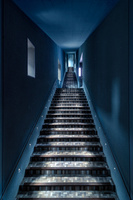
Unless they prefer to take the elevator, visitors enter the galleries via a narrow staircase, first rising along the raw wall of the Goethe Haus before taking a sharp turn to climb the steps that run parallel to the façade, interrupted by the occasional window allowing a glimpse of the outside world. One of the building’s witty elements is that the staircase gets narrower as it ascends, an architectural feature used since the Renaissance to make stairs seem longer, but also prompting a slight claustrophobic feeling (fig. 3). With the walls and ceilings painted in blue, you are simultaneously plunged into one of Romanticism’s iconic colors and an atmosphere of longing associated with its famous symbol, the blue flower.[4] The first exit is to the Goethe gallery housing the painting collection (formerly on display at what used to be the Goethe-Museum). Visitors should not be misled by the new museum’s name and expect a collection dominated by Romantic art, as the Hochstift’s agenda is more broadly to assemble works originating from the period of Goethe’s lifetime and from artists who had some connection to the writer, whether they represent the Frankfurt art scene of his youth or artists whom he befriended or admired later in life.
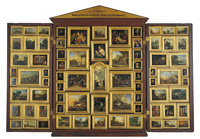
Stylistically heterogeneous and varied with regard to artistic genres, the collection of over five hundred paintings provides an excellent insight into art from Germany or the German-speaking countries dating from circa 1750 to 1850 and has some real gems to offer both in terms of individual works and with regard to their arrangement. The prelude to all of this is the Morgenstern’sche Minaturcabinet (1796–1843), greeting visitors right at the entry to the painting gallery: it is an altar-like cabinet of miniature paintings made and formerly owned by the Frankfurt painter and conservator Johann Ludwig Ernst Morgenstern, his son, and grandson, who fancied reproducing and collating famous paintings in pocket size (fig. 4). Together with the two other miniature cabinets, housed today at the Frankfurt Historische Museum, this small-scale collection suggests the taste of the city’s eighteenth-century collectors, with their particular interest in landscapes, Dutch genre painting, and portraits. The cabinet sets an appropriate tone for the gallery rooms to come, the first of which, entitled “Workshops and Masters,” displays eighteenth-century genre paintings, including some studio scenes reflecting on art and its production.
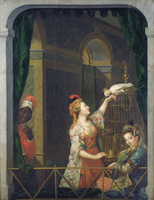
Among the intriguing paintings to follow is Johann Heinrich Tischbein’s (the elder) comparatively large-format portrait of his daughters Amalie (herself an artist) and Wilhelmine in Turkish costume (1780–85). Positioned centrally between two walls in a relatively small room, its display still echoes the painting’s eighteenth-century link to architecture as it was initially made for the artist’s elegant home in Kassel, where it served as one of several panels between the windows. It highlights the period’s exoticizing imaginary, into which a black servant invites the beholders as he pulls aside a curtain at the scene’s margins (fig. 5).
The core rooms of the first-floor gallery pivot around Goethe, his social networks in Weimar, and the personalities of the period, represented by their portraits. Under the rubric “Werther and Faust,” paintings and art objects engaging with the author’s early literary work take center stage. While the craze for the Sturm und Drang epistolary novel and the fateful love affair between its main characters is well known, there are Werther devotions that might surprise even those familiar with the period and leave them bemused or potentially irritated: a porcelain cup and saucer, with the portrait of Werther on the former and of Charlotte on the latter, seems to have initiated a kind of fort/da game whenever the user sipped their coffee.
Beyond the large gallery with the Weimar portraits, the floorplan does not prescribe a particular trajectory, inciting visitors to meander back and forth and to discover rooms of different size, shape, and character. They may sidestep to a space solely dedicated to Johann Heinrich Füssli (or Henry Fuseli as the Swiss-born artist would call himself after his move to London) and the often somber fantasies acted out in his paintings. The concentrated display uniting a set of Fuseli paintings is definitively one of the gallery’s highlights, given that it features such key works as Mad Kate (1806–7, fig. 6) and a version of The Nightmare (1790–91). On the brighter, other side is a spacious hall in which the wall colors change from blue to an uplifting yellow, forming the appropriate background for a display dedicated to Italy, a place of longing for many generations of Northern Europeans (fig. 7). It features the mellow, idealized Italian landscapes of Jakob Philipp Hackert, who was a court artist in Naples at the time when Goethe got to know and admire him and took drawing lessons with him. Combined with the landscapes are portraits relating to Goethe’s Roman acquaintances, perhaps most importantly Anton von Maron’s well-known portrait of Winckelmann at his desk and Angelika Kauffmann’s likeness of a lady wearing an entari over a white muslin dress (1791–95).[5] The two nearly life-size, knee-length portraits make a formidable pair: engaging viewers with the sitters’ gaze and their pelt-lined dressing gown or embroidered, Turkish-style mantle, they combine the sensible and the sensuous (fig. 8).
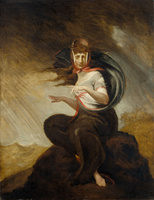
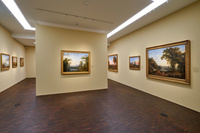
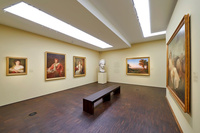
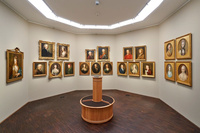
Portraiture is also at the heart of an adjacent, more intimate, polygonal cabinet uniting smaller-scale pastels and oil paintings. Here, the likenesses fill the walls in a salon-style hang and allude successfully to the Enlightenment practice of the collecting and gathering of likenesses as tokens of amity (fig. 9). Under the title “Temple of Friendship,” the display is a nod to the kindred Gleim House, today a museum and once the home of the Enlightenment writer, collector, and prolific correspondent Johann Wilhelm Ludwig Gleim at Halberstadt, in which he surrounded himself with the effigies of his friends.[6] The congregation of heads at the Goethe gallery is complemented by a small portrait of Johann Kaspar Lavater sitting at his desk and sporting his distinct profile. Painted by Johann Heinrich Lips, who also provided many illustrations for the Physiognomische Fragmente (1775–1778), the inclusion of the picture makes a further comment on the significance of portraits at a time when they were thought to bring to the fore a person’s character and soul.
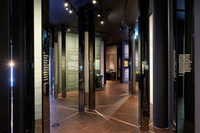
The Romantik Museum’s second and third floor are devoted to Romanticism proper, especially in its literary manifestations, divided into an earlier period under the heading “Romantic Awakening” and the later “Spread of Romanticism.” Their display has a very different tone than that of the painting gallery. Director Anne Bohnenkamp-Renken and the head of the art collections Mareike Hennig teamed up with exhibition designers Petra Eichler and Susanne Kessler and their Frankfurt-based company Sounds of Silence to develop the scenography. Their challenge was to represent Romanticism in a museum display mobilizing largely non-visual material, from hand-written letters to printed books, to tell a story. The results provide a startling experience. Guided by Novalis’s dictum “the mysterious paths lead within,” visitors enter the second-floor gallery via a fun-fair style hall of mirrors, consisting of multiple narrow panes with various historic definitions of Romanticism printed on them (fig. 10). They are thus immediately initiated into the multifaceted nature of the movement as well as to self-reflection and fragmentation as its modes.
The display as a whole is organized into forty-one thematic units or stations, mostly inspired by literary works, letters, or manuscripts. One unit’s topic, for example, is the fascination with the Rhine, especially the deep, rocky Upper Middle Rhine Valley between Bingen and Koblenz, one of the quintessential Romantic landscapes and today a World Heritage Site not least because of its cultural framing by the Romantics. The focus of the museum display is the voyage that the poets Achim von Arnim and Clemens Brentano undertook on this segment of the river in June 1802. Its starting point is a manuscript for a poem “Am Rheine schweb ich hin und her,” jotted down by Brentano on the verso of a theatre poster, revealing the various attempts he made to finalise the verses inspired by the landscape (fig. 11). Throughout the galleries, manuscripts like this one are kept in bespoke cases which resemble standing desks and evoke the moment of writing. Their flaps can be opened by visitors to see the paper object kept under glass, while transcriptions and translations into English are provided on the side. Another material object and exemplary poem sparked the scenographer to tell the story of the journey in yet another way: via a graphic novel in a leporello binding hanging at eye-level from the ceiling (fig. 12). In many galleries, music enriches the themes of individual displays; in this case, Clara Schumann’s musical adaptation of Heinrich Heine’s ballad on the Lorelei (1843) is available either on the museum’s devices or via a smart phone app.
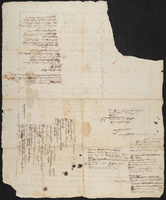
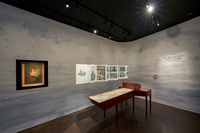
Overall, women and their significant role in the Romantic movement are well represented in the exhibition with their literary productions, letters, social activities, and wit. An immersive display, for example, recreates the remarkable riposte by Caroline von Günderode to an impertinent love letter by Clemens von Brentano, through whose fake tone and intention she sees with striking emotional intelligence. Other displays address the experimental living arrangements of Caroline Schlegel, her husband, and their various friends; Mary Shelly, her Frankenstein (1831–32), and the Romantic Gothic; and the German-Jewish salonière Rahel Vanhagen, whose memoirs are presented under the heading “Equality in Action.”
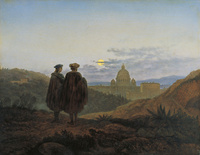
Art history-related themes play an important role in the second- and third-floor galleries, too. One of the stations is, for instance, dedicated to Wilhelm Heinrich Wackenroder’s and Ludwig Tieck’s Outpourings of an Art-Loving Friar and organized around the display of a copy of the 1797 edition of the book along with a small Roman landscape by Carl Gustav Carus titled Erinnerung an Rom II (Memory of Rome), with an imagined Raphael and Michelangelo seen from the back as they stand side by side gazing simultaneously at the moon and the facade of Saint Peter’s Basilica. The painting not only aligns with the admiration of nature and art, but also entwines the themes of friendship, religion, and art contemplation, thus chiming in with major themes of the “Outpourings” (fig. 13). A related unit on the third floor engages with the Lukasbrüder (Brotherhood of Saint Luke) or Nazarenes, an early nineteenth-century male-only group of artists that sought inspiration in religion and the art of the early Renaissance and German Middle Ages in their quest for a genuine, positively naïve, and spiritual art with which they reacted against neoclassicism and the routines of academic training. They are introduced mainly through their prints that celebrate friendship. Nearby is the “Romantic Painting Cabinet,” a small, but exquisite selection of works ranging from landscapes by Caspar David Friedrich and his friend Carl Gustav Carus (including an earlier version of his aforementioned Memory of Rome) to a remarkable group-portrait centered around the French sculptor David d’Angers, as he works on the larger-than-life plaster bust of the Romantic poet Ludwig Tieck while surrounded by an illustrious group of onlookers. This work also testifies to the overarching theme of the third-floor gallery: the increasing international fame of the German Romantics and the movement’s expansion to artists, writers, and philosophers throughout Europe.
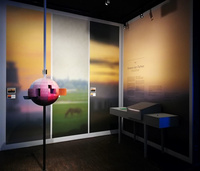
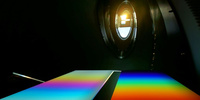
Another station, engaging with art and related theories, is titled “Cosmos of Colors” and offers a truly illuminating display around Goethe’s 1809 color wheel, along with Philipp Otto Runge’s 1810 publication offering a theory of color harmony for painters and proposing his Farben-Kugel or color sphere.[7] While Runge had to draw his hand-colored sphere in the book two-dimensionally, the museum’s scenographers built a three-dimensional color globe visualizing both the beauty and complexity of Runge’s system (fig. 14). Aided by the wall text, this display provides a genuine insight into the color theories of the period, especially those that combined physical and systematic approaches with an interest in the emotional effects of color. This is further explored in a light installation by contemporary artist Olaf Nussbaumer entitled The Rainbow’s Missing Colors (2021) demonstrating the differences between Newton’s and Goethe’s spectrum. It is fitted into a skylight in the roof over the second of the museum’s stunning staircases, which curves elliptically down the three floors. Light is filtered through a regular and a partially shaded prism, producing—sunny weather permitting—on two parallel screens installed at the bottom of the staircase the Newtonian prism with the colors of the rainbow and, next to it, Goethe’s inverted prism comprising magenta, purple, and turquoise (fig. 15).
Runge is also at the heart of another unit, “The Times of Day,” thematizing the artist’s “plans for Romantic synthesis of the arts” (as the wall text states) around the engraved version of his drawing cycle Morning and Evening, Day and Night (1805). These engravings are just one example of the significant collection of prints and drawings owned by the Freie Deutsche Hochstift. Highlights from it are on display in the Romantik-Museum’s first major exhibition Zeichnen im Zeitalter Goethes (Drawing at the Time of Goethe), on display until November 6, 2022.[8]
All things considered, the Deutsches Romantik-Museum is a fantastic addition to Frankfurt’s versatile museum landscape, and especially worth visiting for anyone interested in nineteenth-century art and culture, both for its rich collections and the imaginative ways in which they are put on stage in their remarkable new home.
Notes
[1] This was the society’s full official name. See Joachim Seng, “The Freies Deutsches Hochstift for the Sciences, Arts and General Education,” in The Frankfurt Goethe House—Freies Deutsches Hochstift (Frankfurt am Main: Freies Deutsches Hochstift, 2009), 22.
[2] For a history of the society and its collections, see Seng, “The Freies Deutsches Hochstift for the Sciences, Arts and General Education.”
[3] There is a media guide that can be used via a smartphone while visiting the galleries. It is a good way to get a sense of the different sections of the museum, the individual rooms and the objects displayed in them, and to access the wall texts in both German and (slightly less comprehensively) English: https://freies-deutsches-hochstift.de/. The collections, as such, are digitized via the website “Museum-Digital” with information partially available in English: https://www.museum-digital.de/. For the paintings see https://hessen.museum-digital.de/. The Freies Deutsches Hochstift is still in the process of digitizing its collections: https://goethehaus.museum-digital.de/.
[4] For a presentation of the architecture and further photographs see https://www.baunetz-architekten.de/.
[5] The portrait of Winckelmann is a late eighteenth-century copy of the 1786 original today on display at the Gemäldegalerie in Weimar. It was executed either by Maron himself or is the work of an unknown copyist as suggested in the latest catalogue of the painting collection. See Petra Maisak and Gerhard Kölsch, Frankfurter Goethe-Museum. Die Gemälde. Bestandskatalog (Frankfurt am Main: Freies Deutsches Hochstift, 2011), 172–74.
[6] The Gleimhaus has been a museum since 1862. See https://www.gleimhaus.de.
[7] Philipp Otto Runge, Farben-Kugel oder Construction des Verhältnisses aller Mischungen der Farben zu einander, und ihrer vollständigen Affinität, mit angehängtem Versuch einer Ableitung der Harmonie in den Zusammenstellungen der Farben (Hamburg: Perthes, 1810).
[8] A substantial catalogue introduces drawings and watercolors by eighty artists: Mareike Hennig and Neela Struck, eds., Zeichnen im Zeitalter Goethes (Munich: Hirmer, 2022).